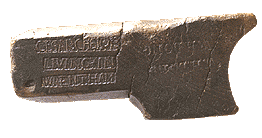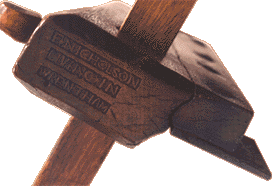
Cesar Chelor was a slave who belonged to colonial entrepreneur and earliest documented American planemaker, Francis Nicholson (1683-1753). Chelor became Nicholson's apprentice and later became a planemaker in his own right. When Nicholson died in 1753, he willed Chelor his freedom, a workshop, and the tools and material to continue on independently. Chelor has the distinction in being the earliest documented African American toolmaker in North America.
Acknowledgments
Cesar Chelor's legacy has survived because of a small group of tool collectors dedicated not only to finding interesting tools but also to researching the men who made them. In addition to recovering extant tools, researchers have gone back to these New England towns and looked up court registries, church lists, cemetery records, and census records in a quest for the worth of men's estates and their birth and death dates. In the United States, the Early American Industries Association is the source of most research on the history of tools and industrial practice. Much of the information for this exhibit comes from consulting members and researching publications of the EAIA. We would like to thank the EAIA, the Pollak family, and Herb Kean for their aid and support in preparing this exhibit.

Francis Nicholson (1683-1753) the father and founder of the business.
Francis Nicholson moved from Rehoboth, Massachusetts to Wrentham, Massachusetts in 1728. In colonial times, Wrentham was a small, growing town that was on the main road to Boston. As a result, there were plenty of travelers and plenty of business. It was a good place for an ambitious tradesman. Nicholson was married four times and was a deacon of his church. Among the other businesses he had, Nicholson also owned a mill.
John Nicholson (1712-1807) Francis' son.
John Nicholson was an apprentice to his father. Francis and John worked together in Wrentham until John moved several miles away to Cumberland, Massachusetts in 1739. In 1763, ten years after his father's death, John moved back to Wrentham. In records of this time, John is referred to as a "gentleman," which indicates he did not return to be a planemaker. A reasonable theory could be that as a successful businessman, with land and businesses inherited from his father, he needed to be in Wrentham.
Cesar Chelor.
Chelor's birthdate and place of birth is not known, as he was a slave and this information would not have been recorded. We do know that Chelor was owned by Francis Nicholson as early as 1736. He was admitted as a member to the Congregational Church in Wrentham Center in 1741, probably around the age of 21. In 1758 he married Juda Russell and had eight children. He died without a will in 1784 with an estate inventory valued at 88 pounds 2 shillings.


